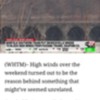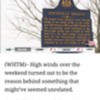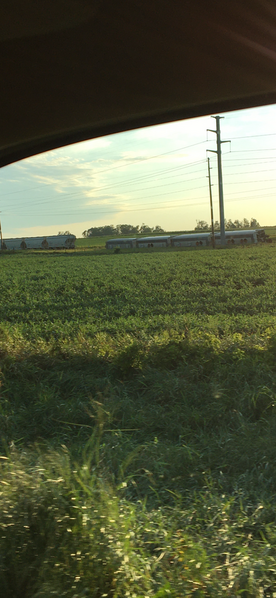The pictures they collected aren't very thrilling, but the idea is interesting. I wonder if any engineers (train and/or civil) can explain this 'shielding' a lighter train from wind while on a bridge. It seems plausible but when is the last time a train blew off the tracks?
Replies sorted oldest to newest
Well then, check this out!...
That was in 2008...while traversing a bridge, no less! And probably not "the last time"!
One can imagine the engine crew probably needed a change of clothes after this experience!!!!
![]()
I've seen a container blown off the Rockville bridge into the river. Probably around 2010 maybe?
@woodsyT posted:The pictures they collected aren't very thrilling, but the idea is interesting. I wonder if any engineers (train and/or civil) can explain this 'shielding' a lighter train from wind while on a bridge. It seems plausible but when is the last time a train blew off the tracks?
Obviously NS knows that the winds could blow a train off the tracks or they wouldn't go to that much trouble to prevent it. ![]()
Some years ago a freight consist blew off of the Mississippi River bridge on the New Orleans side during a hard wind storm. I heard the account recently from a friend who lived there and said some fellas he knew were eating at a nearby diner when all of a sudden cars started dropping out of the sky! This is the older Huey P Long bridge and it is quite high.
after the number of replies I googled it. It's happened plenty.![]()
The Key West RR in the hurricane of 1935. Wind took trains of the tracks and destroyed most of the infrastructure other than the bridges. Flagler couldn't pay to build it all back in the depression so the highway was born.
There's a spot off Hwy 87 west of Clayton, NM, heading toward Raton, NM, next to the Texas border, where the BNSF has a busy line that goes between Dallas/Ft. Worth and Denver. After paralleling Hwy 87, the line turns north. At that spot, on an adjacent section of track on the west side of the main line, the BNSF has parked, semi-permanently, a line of hoppers loaded with something, as a shield for the trains from the frequent westerly/northwest winds that blow across the prairie there. They have some impressive winter storms and strong winds at that location. As they sometimes say in Texas, it's a place where there's nothing between you and the North Pole except 4 strands of barbed wire. I'm sure Tom (Number 90) is familiar with the spot.
Both the railroad and highway bridges that cross the Susquehanna between Perryville and Havre de Grace in MD are occasionally closed due to high winds. There are four bridges that cross fairly close to each other at that location including US40, I95, CSX, and Amtrak.
NS ex-NYC across the Sandusky Bay - it has happened several times, especially empty TOFC / container trains.
@woodsyT posted:The pictures they collected aren't very thrilling, but the idea is interesting. I wonder if any engineers (train and/or civil) can explain this 'shielding' a lighter train from wind while on a bridge. It seems plausible but when is the last time a train blew off the tracks?
NS has lost several containers and empties on the Rockville Bridge due to high winds coming down the river valley and have place heavy trains on the bridge several times in the past to prevent additional loses of empties and light cars.
Happened several times on BNSF between KC and Wellington, Usualy intermodal or stack trains with empty containers. Some moving, some stopped.
I'm getting the impression that this is not an isolated occurrence! ![]()
Last summer on the UP main in southern Arizona during Monsoon season I talked with the engineer on an east-bound double-stack container train stopped at a green signal just a little East of Dragoon, which is the summit of the pass between Benson and Wilcox. I climbed up the embankment from the access road and asked why he was waiting at a green signal. He told me the dispatcher had ordered the stop because of high winds in the area and the danger of containers and railcars being blown over. I hadn't heard of that before, but it makes sense considering the amount if surface area a double-stack presents to the wind.
@gunrunnerjohn posted:I'm getting the impression that this is not an isolated occurrence!
Correct. Going way back to the 1950s on the original Great Northern Rwy, there is a curve within a canyon, in the Rocky Mountains of Montana. The wind, coming down from Canada, can be so strong that freight cars would be blown over. The GN installed a wind speed indicator at that location, with data being transmitted to the Dispatcher's office. When the wind speed was so high, it presented a danger to the trains, the Dispatcher would stop either westbound and/or eastbound trains prior to that curve, until the winds subsided. I would bet that BNSF still monitors the winds in that area.
And I believe - perhaps I'm wrong - that the containers are only locked to each other, not to the deck of the well car that carries them.
@Hot Water posted:Correct. Going way back to the 1950s on the original Great Northern Rwy, there is a curve within a canyon, in the Rocky Mountains of Montana. The wind, coming down from Canada, can be so strong that freight cars would be blown over. The GN installed a wind speed indicator at that location, with data being transmitted to the Dispatcher's office. When the wind speed was so high, it presented a danger to the trains, the Dispatcher would stop either westbound and/or eastbound trains prior to that curve, until the winds subsided. I would bet that BNSF still monitors the winds in that area.
According to their site, they still do. With dispatchers receiving then notifying relevant crew. They also came up with a system and created an app that the train crew can access in real time with that data.
The site also mentions the MOW, etc. crew have handheld anemometers.
My niece and her husband live in Great Falls, MT, and those winter winds are no joke.
@breezinup posted:There's a spot off Hwy 87 west of Clayton, NM, heading toward Raton, NM, next to the Texas border, where the BNSF has a busy line that goes between Dallas/Ft. Worth and Denver. After paralleling Hwy 87, the line turns north. At that spot, on an adjacent section of track on the west side of the main line, the BNSF has parked, semi-permanently, a line of hoppers loaded with something, as a shield for the trains from the frequent westerly/northwest winds that blow across the prairie there. They have some impressive winter storms and strong winds at that location. As they sometimes say in Texas, it's a place where there's nothing between you and the North Pole except 4 strands of barbed wire. I'm sure Tom (Number 90) is familiar with the spot.
I sure do know the siding you are referring to. This former Colorado & Southern line mainly had coal trains plus one or two mixed freight trains on it. In the last few years, though, it has picked up about 3 intermodal trains daily, and that will make the theme from Dragnet start playing when the wind blows. It was never part of my territory, but we have a son who lives in Denver, and we pass the siding every time we drive to Colorado.
Out here on the Great Plains, wind interference with trains has been occurring for some time, beginning with the switch from boxcars to trailers and containers on flatcars. The profile of intermodal cars, as well as empty jumbo hoppers, catches more wind than did the smaller cars of the steam and early diesel eras, which rarely were blown over by wind.
There would be a lot more wrecks due to wind, but the railroads in this territory have identified the problematic areas and trains are stopped before entering the places where wind speeds are too high. BNSF has some high bridges in the badlands of North Dakota and eastern Montana on the former Great Northern and Northern Pacific, where a valley will drop out of the grassy plains, and at least one of the bridges has been equipped with wind baffles.
If you are driving across the plains on a paralleling highway, you might notice an anemometer mounted above a signal house here and there. If the railroad has an anemometer up there spinning in the breeze, you are in an area being monitored for dangerous side winds.
I never realized winds could affect a train until we rode the California Zephyr / Rocky Mountaineer west from Denver. As we were climbing, the guides pointed out the wind break made from old hopper cars. Said they were welded to the rails and filled with gravel. Not the best quality images shooting through the windows but here are two photos we took:












